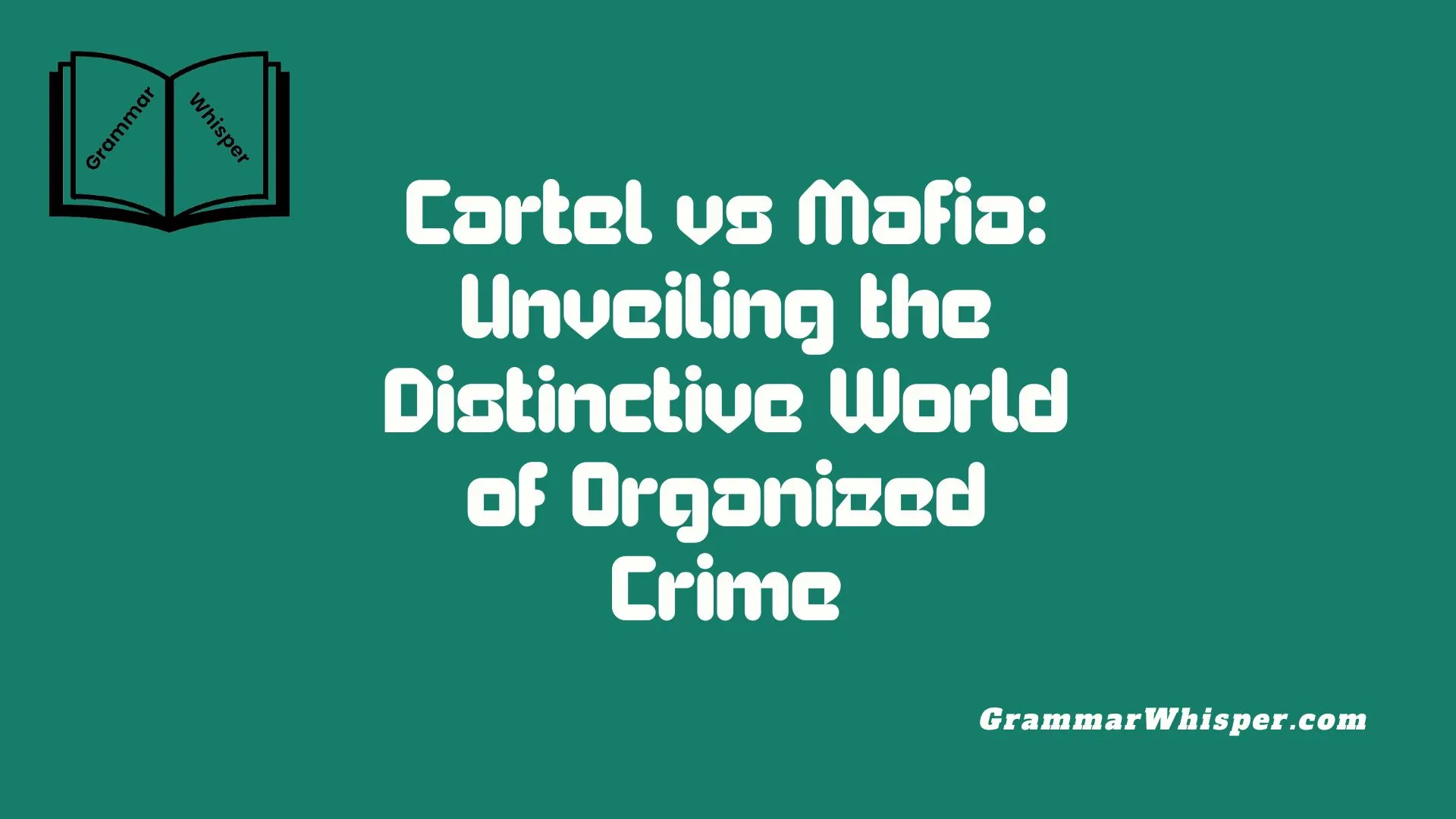The world of organized crime has long captivated the public’s imagination, especially when it comes to the two most notorious forms: the Cartel vs Mafia. Both groups operate outside the law, but their origins, structures, and methods differ significantly. From my experience studying this topic, understanding these differences is crucial not only for law enforcement and policymakers, but for anyone interested in the dynamics of global crime syndicates.
These groups may seem similar at first glance, but the way they function and influence society is quite distinct. The mafia tends to have a more hierarchical and family-based structure, focusing on controlling specific territories through intimidation and corruption. On the other hand, cartels often operate with a looser, more business-like model, heavily involved in drug trafficking and violent disputes. Grasping the origins and methods of these two organized groups helps reveal the complex nature of the global underworld and highlights why tackling these crime syndicates requires tailored strategies.
Understanding the Terms: Cartel and Mafia
Mafia
The term “Mafia” traditionally refers to a structured criminal organization with roots in Sicily, known as Cosa Nostra. Over time, the concept expanded to include various Italian-American crime families operating under a hierarchical system. The Mafia is characterized by its code of silence (omertà), loyalty, and a focus on control through influence and corruption.
Cartel
A “Cartel” typically denotes a coalition of independent organizations formed to regulate production, pricing, and marketing of goods. In the criminal context, it refers to large, often decentralized, drug trafficking organizations, especially prominent in Latin America. Cartels are known for their use of extreme violence, territorial control, and diversified criminal activities.
Historical Roots: From Sicily to International Syndicates
The Mafia: A Sicilian Legacy
Emerging in the 19th century, the Sicilian Mafia filled the power vacuum left by weak governmental structures. They offered protection and arbitration in exchange for loyalty and payment. The Mafia’s influence expanded to the United States during the early 20th century, leading to the establishment of powerful families in cities like New York and Chicago.
The Rise of Cartels
Drug cartels gained prominence in the late 20th century, particularly in Colombia and Mexico. The Medellín and Cali cartels dominated the cocaine trade in the 1980s and 1990s. Following their decline, Mexican cartels like the Sinaloa and Jalisco New Generation Cartel (CJNG) rose to power, controlling significant portions of the drug trade into the United States and beyond.
Organizational Structures and Strategies
Mafia Hierarchy
The Mafia operates under a strict hierarchical system
- Boss (Don): The head of the family.
- Underboss: Second-in-command.
- Consigliere: Advisor to the boss.
- Caporegime (Captain): Leads a crew of soldiers.
- Soldiers: Carry out day-to-day operations.
This structure emphasizes loyalty, secrecy, and a clear chain of command.
Cartel Networks
Cartels often have a more fluid and decentralized structure:
- Leadership: May consist of a single leader or a group.
- Operational Cells: Handle specific tasks like trafficking, enforcement, or finance.
- Alliances: Form temporary partnerships with other groups for mutual benefit.
This flexibility allows cartels to adapt quickly to law enforcement pressures and market changes.
Criminal Activities: A Comparative Overview
| Activity | Mafia | Cartel |
| Drug Trafficking | Involved, but not the primary focus. | Primary activity, especially cocaine and meth. |
| Extortion | Common, often under the guise of protection. | Widespread, including threats to businesses. |
| Money Laundering | Extensive use of legitimate businesses. | Utilizes various methods, including crypto. |
| Human Trafficking | Less common. | Significant involvement. |
| Arms Trafficking | Limited. | Extensive, often linked to violence. |
| Political Corruption | Deep infiltration in local governments. | Bribes and intimidates officials. |
Cultural Perceptions and Misconceptions
The Mafia Mystique
Popular media has romanticized the Mafia, portraying them as honorable criminals with codes of conduct. Films like The Godfather and Goodfellas have contributed to this image, often downplaying the brutality of their operations.
The Cartel Reality
In contrast, cartels are depicted as ruthless and violent, with shows like Narcos highlighting their brutal tactics. While these portrayals are closer to reality, they can still glamorize the lifestyle, attracting misguided admiration.
Global Influence: Cartel and Mafia Today
Mafia’s Modern Presence
While the Mafia’s influence has waned in some areas, they remain active in various sectors
- Italy: Groups like the ‘Ndrangheta and Camorra continue to wield power.
- United States: Though diminished, families still operate in cities like New York and Chicago.
- International: Involvement in global money laundering and cybercrime
Cartel Expansion
Cartels have expanded their reach beyond Latin America:
- United States: Major suppliers of illicit drugs.
- Europe: Increased presence in drug markets.
- Africa and Asia: Emerging markets and transit routes.
Their adaptability and use of technology have facilitated this global expansion.
Case Studies
Sinaloa Cartel’s European Operations
In May 2025, a joint operation by French and Belgian police, supported by Europol, dismantled a network linked to the Sinaloa Cartel. The group was involved in producing and trafficking synthetic drugs across Europe, utilizing chemicals sourced from China and cryptocurrencies for financial transactions. Sixteen individuals were arrested, highlighting the cartel’s international reach.
‘Ndrangheta’s Infiltration of Football Clubs
The ‘Ndrangheta, Italy’s most powerful mafia, has been linked to the murder of Inter Milan’s ultra fan leader Vittorio Boiocchi in 2022. Investigations revealed the mafia’s involvement in drug and protection rackets within football fan groups, showcasing their influence beyond traditional criminal activities.
Conclusion
While both the Mafia and cartels are entrenched in organized crime, their methods, structures, and cultural perceptions differ markedly. The Mafia’s hierarchical and secretive nature contrasts with the cartels’ decentralized and overtly violent operations. Understanding these distinctions is vital for developing effective strategies to combat their influence and protect communities worldwide.
FAQs
What is the main difference between a cartel and a mafia?
The main difference lies in structure and operational strategy. A mafia is typically a hierarchical organization with strict internal codes (like omertà), often involved in long-term, low-visibility crimes such as racketeering, extortion, and infiltration of legitimate businesses.
A cartel, on the other hand, is usually more decentralized and militarized, primarily focusing on high-volume, high-violence drug trafficking. Cartels often form flexible alliances and use extreme violence as a tool of intimidation and control.
Are drug cartels more dangerous than the mafia?
In terms of public violence and brutality, cartels are generally considered more dangerous. Many cartels, especially in Mexico and Colombia, are known for their beheadings, kidnappings, and massacres, which are used both as control mechanisms and psychological warfare.
However, the mafia’s danger lies in its deep-rooted infiltration into government and business, making them harder to detect and often more influential in political and economic circles.
Do the mafia and cartels ever work together?
Yes, there have been instances of collaboration between cartels and mafia groups, especially in international drug trafficking. For example, Italian mafias like the ‘Ndrangheta have acted as European distributors for South American cartels, using their existing smuggling routes and financial systems.
These partnerships are usually transactional, based on profit rather than loyalty or shared ideology.
How do law enforcement agencies combat cartels and mafia differently?
Law enforcement uses different strategies based on the organization’s structure and activities:
- Mafia investigations focus on surveillance, long-term wiretaps, and financial audits to dismantle hierarchies and prosecute under RICO laws (in the U.S.).
- Cartel takedowns often involve military-style interventions, joint international task forces, and intelligence coordination due to their high violence and cross-border operations.
Both require international cooperation and advanced financial tracking techniques to follow money laundering networks.
Which countries are most affected by cartels and mafia today?
- Cartels primarily affect countries in Latin America, especially:
- Mexico (Sinaloa, CJNG, Gulf Cartel)
- Colombia (Clan del Golfo)
- Guatemala & Honduras (as transit zones)
- United States (as a major market)
- Mafia organizations are most influential in:
- Italy (‘Ndrangheta in Calabria, Camorra in Naples, Cosa Nostra in Sicily)
- United States (New York, Chicago, Philadelphia)
- Canada, Germany, and Australia (increasingly active)











